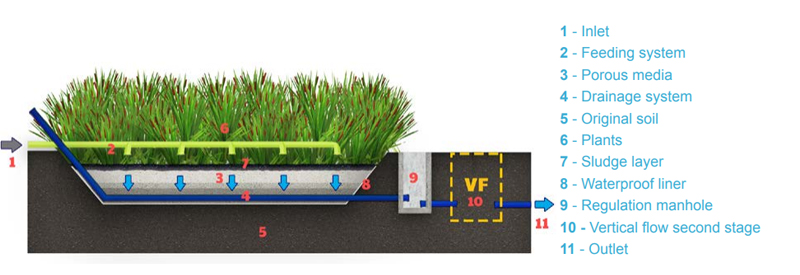- Mitigation title
- French vertical flow wetlands
-

- Description
-
The French Vertical Flow Wetland is simply a specific configuration of a Vertical Flow (VF) Wetland. It consists of two stages with different filtration media, and each stage contains alternately operated cells to allow for the treatment of raw wastewater.
The first stage, which is often know as a French reed bed, acts as a mechanical screening for raw sewage and as a form of sludge treatment. The second stage is similar to a typical VF wetland where final organic matter is removed.
- Advantages
-
- Reuses water
- Can be fed by gravity (low energy use)
- Biodiversity enhancement
- Carbon sequestration
- Disadvantages
-
- Produces methane
- Large land footprint
- Feeding system requires mechanical component
- Health and safety concerns around algal blooms prohibit public access
- Parameters
-
- Phosphorus
- Ammonia
- Nitrogen
- Coliforms
- BOD/COD
- Suspended Solids
- Carbon footprint
-
- Short term energy requirements for earth works
- Medium-long term energy requirements for wetland operation
- Time to become effective
-
- Gravel filtration will immediately remove suspended sediment
- Removal of nutrients / organic matter will first need vegetation to become established
- Maintenance
-
- Gravel needs to be renewed as required
- Sludge needs to be removed from primary tank as required
- Sludge deposit from stage one treatment must be removed once it reaches a depth of 20 cm
- Suggested cutting back of plants and removal of litter every two to three years
- Performance with time
-
- Performance can be kept at optimum with well a well-established maintenance schedule
- Performance fluctuates with seasonal changes; lower in autumn/winter, highest in spring/summer
- Scaling considerations
-
The size of the wetland is correlated to the load of nutrient removal. Design criteria to meet:
- Monitoring required of the inlet and outlet concentrations and a Population Equivalent must be evidenced.
- Hydraulic and mass loading will directly impact sizing, aspect ratio, and depth.
- Must take into account climate factors and account climate change, such as droughts and dry weather, or water gains from rainfall, etc. As well seasonal dynamics and differences in flows through different seasons.
- Ecology and plant community; what plant species to use.
- References
-
Alexandros Stefanakis, C. S. (2014). Vertical Flow Constructed Wetlands. Eco-engineering Systems for Wastewater and Sludge Treatment.
Dotro, G., G Langergraber, Pascal Molle, Nivala, J., Jaume Puigagut Juárez, Stein, O.R., Marcos Von Sperling and Iwa. (2017). Task Group On Mainstreaming The Use Of Treatment Wetlands . Treatment wetlands. London: Iwa Publishing.
ICRA. (n.d.). French Vertical Flow Wetlands.
Ricardo for Herefordshire Council. (2021). Interim Phosphate Delivery Plan Stage 2, Mitigation options for phosphate removal in the Wye Catchment.
Silviya Lavrova, B. K. (2013). Nutrients and Organic Matter Removal in a Vertical-Flow Constructed Wetland. Applied Bioremediation.
Wetland Engineering. (n.d.). Treatment Wetlands. Retrieved from https://wetlandengineering.co.uk/treatment-wetlands
